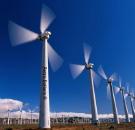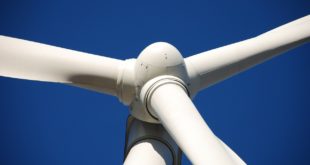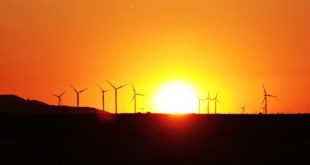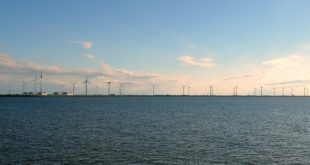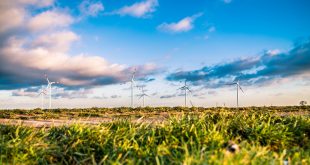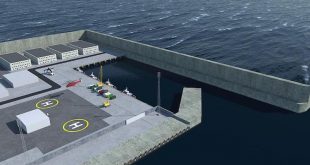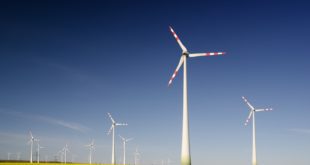Bigger windmills mean lower cost per kWh. Therefore the mainstream of the market is 2-3 MW (Mega Watt = 2000-3000 kW peak capacity) windmills. Their average yield is up to 1 MW, depending on wind conditions.
However, big systems also bring big problems with them: complexity of installation, accessibility, maintenance. But moreover, they require a very “strong” net (mains). Currently, even strong nets can not handle more than 25-30 % participation of the big systems. The worst case scenario must be considered: maximum wind output at lowest power requirement at any time. In the western world, due to industrialization, the difference between minimum use and average use is not that big, but it reduces the wind *********** anyway. As the average and maximum yield differ substantially, this further reduces the wind ***********. The big systems have (costly) options to waste energy into dummy loads in extreme cases, but practically, the maximum wind *********** is around 10% of the average power use, In Western hemispheres this is currently also seen as a practical limit because of the limitations to place wind mills on land (people do not like the view). Ten percent, as useful as it is, is not even covering the growth of energy use.
For the big windmills the best option to expand is offshore wind parks. Advanced control systems will need to intelligently switch towers on and off or better: use storage for the excess energy. When this is perfectly implemented, 25-30% of the average use can be wind energy. The Netherlands is one of the countries focusing on offshore wind parks. Recently the world’s second largest offshore wind park was commissioned. The latest development from Norway are floating windmills, tied to the bottom of the sea.
I installed the first windmill in the Caricom (Eastern Caribbean islands) at Paradise Bay, a hotel and resort community in Grenada. The owners of the villas and the resort enjoy savings of up to 20%, while the electricity company also saves on energy cost. This is a clear case that serving the environment can be even profitable. The windmill will be commissioned later this year.
In smaller markets -such as the Caribbean- big is not as beautiful as in the West as the nets are relatively small and the infrastructure to install and maintain the big systems is limited. A company from the Netherlands (www.mainwind.nl) recognized this gap and delivers solutions in the form of used mid-range windmills (250-750 kW) that come from upgraded wind parks. The need for upgrading is obvious; it is most easy to increase capacity to the now current technology (2 – 3MW) at already existing wind parks. The smaller windmills are taking down, completely revised (reconditioned) and are sold with an as-new warranty and optionally with a 15 year all-inclusive maintenance contract. The cost per kWh is competitive with larger windmills, typically between 7-9 US$ cents; 5-6 times lower than the mains.
While this is a very lucrative investment, local bankers seem to have cold water fear, so there is an opportunity here for those who want to please both the environment and their wallet!
Photovoltaic systems used to be only suitable for small-scale energy requirements. This is changing thanks to increasing production and subsidized use by western governments, Currently PV solar can not compete with wind energy, but on the long term drastic improvements are to be expected. A long term vision that new houses are covered wit solar roofs is getting within sight.
Solar systems have the advantage of low maintenance (only cleaning) and can also save some cost by replacing traditional roofing systems.
In the Caribbean, PV solar systems are already getting close to the cost of generating electricity from fossil sources because of the intense sunshine and high cost of diesel, Once the production cost of PV solar systems further decreases, they will create savings for their owners. This will likely induce a massive breakthrough.
An even more awarding source of solar energy in the Caribbean is the solar water heater. They produce abundant hot water and the installed cost can be as low as 800 US$ for a 50 gallon system. In many cases they pay for themselves in 2-3 years. Yet, they are far from popular. Awareness is the issue,
An aspect specific to solar systems in the Caribbean is protection against hurricanes. In affected areas, proper measures need to be taken. PV systems should best be covered with plywood panels, ready to fit. Solar water heaters should either be covered or taken out in case of a hurricane. While all this requires attention in designing the setup, the good news is that the related cost is not significant.
HYDRO
Using water force as an energy source is not new. Some countries, such as Canada, rely heavily on hydro power. Clearly, the availability is limited to specific areas. And to make efficient use of hydro power, the scale must be sufficient. While the contribution of hydro is important, it is not expected to belong to the main stream in terms of aggressive growth of green energy on a global basis. In the Caribbean, there are options but cost may be a prohibitive factor.
GEOTHERMAL
Earth heat bases on the 9000° F inner earth temperature and gradually reduces in temperature closer to the surfaces, but the temperature close to the surface varies greatly. Rainwater that sips in deeper parts of the earth gets hot and is called a geothermal source. In some parts of the world this water finds its way back to the surface via cracks and faults, such as geysers (i.e. in Iceland) and hot springs. As with solar energy, the issue is how to tap that virtually unlimited source of green energy. In most cases the trick is to drill to find and get access to the geothermal source. The hot water can than be used both direct and in geothermal power plants, which consists in 3 varieties. Steam can directly be used to generate electricity with a dry steam generator. Water between 300-700°F can be used in a Flash Power Plant, where hot water is flashed into steam, Water with a temperature as low as 220°F can be used in a Binary Power Plant, where the hot water indirectly produces steam from a fluid with a lower boiling point using heat exchangers. The used water is fed back into the source for reheating. It is renewable in a sense, as the available heat capacity has its limits.
Currently, the worldwide capacity of geothermal power plants is over 9,000 MW. The energy cost of “easy access” geothermal energy power plants is comparable to wind energy. An MIT study showed that it is feasible to increase the capacity in the US alone to at least 100,000 MW, requiring an investment of up to 1 Billion US$. It is comparable to drilling for oil; the more you want, the more difficult (expensive) it is to find the sources. Clearly, geothermal energy can become a major contributor to the world’s energy needs on the long term. Geothermal power plants can adjust the output to the required needs, which is a significant advantage and makes them very suitable for “base load power” (the amount of energy that is “always” needed).
In the Caribbean the Lesser Eastern Antilles are known to have potential for geothermal energy. Guadeloupe has a 4 MW plant from shallow high temperature wells since 1984. Explorations have shown encouraging results in Dominica, Montserrat and St. Lucia. Dominica is the most active in picking up the challenge.
TIDAL ENERGY
If there is one thing we can safely predict and be sure of on this planet, it is the coming and going of the tide. While the energy capacity is reliable, converting it into electrical power is not easy. One option is to build a “tidal barrage” (compare to hydro lakes) which are not only complicated but also cause drastic changes to the currents in the estuary that could have huge effects on the ecosystem. Nevertheless, tidal barrages have a huge potential, worth while further exploration.
Another option is to use offshore turbines that work comparable to wind parks, but underwater and using the tides as a source, This technology brings no ecological issues, but as it is in a early stage, the cost is not yet competitive (like wind energy in the early days). Once cost gets competitive it offers a huge potential and can be applied anywhere where the tides are suitable, which includes the Caribbean.
BIO-MASS ENERGY
Wood used to be our main fuel, utilized to heat and cook. Wood still provides some of the energy we use, but its importance as an energy source is dwindling. Sugar cane can be fermented to make alcohol, which can be burned to generate power. Alternatively, the cane can be crushed and the pulp (bagass) can be burned, to make steam to drive turbines. Other solid waste products can be converted into steam for a power plant as well. The bioconversion process uses plant and animal wastes to produce fuels such as methanol, natural gas, and oil. Manure, corn stalks, wood chips, seaweed, and other waste products can be used. A disadvantage is that burning causes greenhouse gases.
ENERGY CONSERVATION
Lighting is a major energy consumer and responsible for 12-15% of the total CO2 emission. CFL’s (energy saving lamps) were a step forward, but have the disadvantage of using poisonous mercury and phosphor. LED lamp suppliers claim sustainability but the majority of their product lifetime is equal to CFL’s. Lemnis Lighting, a Dutch hi-tech company, developed Pharox, a LED Lamp with an amazing lifetime of 50,000 hours. Compare to 1,000 hours for traditional (incandescent) light bulbs and 6,000 hours for CFL’s. The power consumption of the Pharox lamp is only 3.4 Watt, compared to 6 Watt for a CFL and 40 Watt for a traditional light bulb. More information: http://www.lemnislighting.com This solution not only saves a lot in energy consumption, but also saves CO2 in production because of the long lifetime.
To put this in perspective: When all American households would replace four incandescent light bulbs with four Pharox lamps, this would save 22 billion kWh per year. Over the lifetime of the lamp this would have saved 347,000 tons of CO2 emissions, the equivalent to planting 507,000 trees, according to John Rooymans, CTO of Lemnis. The company is substantially increasing production capacity as they can currently not meet the demand. Availability of Pharox lamps in the Caribbean is expected in the course of 2008. Until then the regular energy saving lamps are the best option, which cost essentially the same as traditional light bulbs (six times more expensive but 6 times longer lifetime) but use 5.5 to 6.5 times less energy.
Refrigerators are the next major opportunity to save energy. At this time, almost all refrigerators sold in the Caribbean are bought on the basis of purchase cost alone. Other than in most western countries, the consumer is not informed about the power consumption of a refrigerator. The most efficient refrigerator (A++) has an energy index of 30 while the least efficient (cheapest in purchase) refrigerator (G) is 125. That means four times more power consumption! Over the lifetime of the refrigerator, people spend more money on wasted energy than on the refrigerator itself. In Europe, classes D, E, F and G are meanwhile banned, which reduces the difference to a factor 3. A similar approach goes for washing machines were the most efficient version scores two times better than the worst. For other household appliances the same principle is valid, while the impact is usually less.
CONCLUSIONS
On a worldwide basis, green energy is a viable option, both on the short and long term, but requiring investments to achieve a substantial contribution. In the Caribbean, the options are essentially the same, but practically wind and solar energy are the most promising short term solutions. Economically, wind energy has the best options at this time, with solar as the runner-up. The model where owners of windmills sell the excess energy to the electricity company at a price far below their fuel cost is a very promising one, especially now that the windmills from upgraded wind farms are offered to the market at favorable conditions. But also electricity companies in the Caribbean can use this opportunity to quickly and dramatically save on fuel cost.
 Alternative Energy HQ solar power for homes, wind energy, and bio fuel issues
Alternative Energy HQ solar power for homes, wind energy, and bio fuel issues

